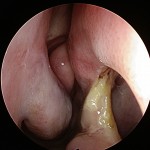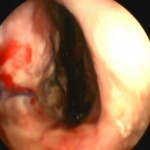Nasal septal perforation repair: predictive factors and systematic review of the literature
Nasal septal perforation (NSP) can occur by numerous causes including previous septal surgeries, trauma, inflammatory diseases, and the use of nasal spray [1]. Although most patients with NSP remain asympto- matic, a significant minority suffer from debilitating symptoms such as nasal obstruction, crusting, epi- staxis, and postnasal drip [2]. Conservative manage- ments including nasal irrigation with isotonic saline, application of antibiotic ointment, or prosthesis such as a septal button can diminish problematic symptoms, yet surgical repairs are required for patients who do not respond to conservative treat- ments [3,4&&]. Many surgical techniques, approaches, flaps, and interpositional grafts have been reported. However, surgical techniques have not been stand- ardized and the keys for successful closure have not been completely elucidated [5]. The objectives of this systematic review were to assess available literature on the surgical repair of the NSP and to search for the predictive factors for successful repair.
Systematic literature review
We performed a systematic literature search of MEDLINE via PubMed, SCOPUS, Web of Science, and the Cochrane Ear, Nose and Throat Disorders Group Trials Register (The Cochrane Library, Issue 6, 2011) without language restriction except for articles in which English translation was not available for the period of January 1960 to June 2011. The search was conducted by both authors (K.S.-W. and R.C.-S.) independently to identify suitable articles for review. Medical subject headings (MeSH) and main keywords used in the database searches were nasal, septal, perforation, management, surgi- cal, repair, and predictive factor. We also scanned the references in the retrieved articles.
No randomized prospective controlled studies dealing with the management or predictive factors.
Nasal septal perforation repair using intranasal rotation and advancement flaps
Before operation:
- Didelė nosies pertvaros skylė
- Didelė nosies pertvaros skylė
- Didelė nosies pertvaros skylė
After operation:
- Kairė nosies pusė. Skylė uždaryta
- Vaizdas po 14 dienų
- Dešinė nosies pusė. Skylė uždaryta






